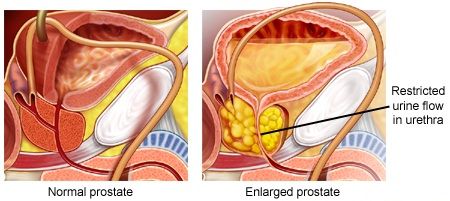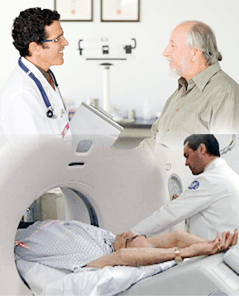Prostate Cancer
 The prostate is part of a man’s reproductive system and is a walnut-sized gland located between the bladder and the penis. The prostate is just in front of the rectum. The urethra runs through the center of the prostate, from the bladder to the penis, letting urine flow out of the body. The prostate is a gland. The prostate cancer is the most common type of cancer in men. Prostate cancer is the second leading cause of cancer death in men, exceeded only by lung cancer. Adenocarcinoma of the prostate is the clinical term for a cancerous tumor of the prostate gland. As prostate cancer grows, it may spread to the interior of the gland, to tissues near the prostate, to sac-like structures attached to the prostate (seminal vesicles), and to distant parts of the body (e.g., bones, liver, lungs). Prostate cancer confined to the gland often is treated successfully. The prostate is part of a man’s reproductive system and is a walnut-sized gland located between the bladder and the penis. The prostate is just in front of the rectum. The urethra runs through the center of the prostate, from the bladder to the penis, letting urine flow out of the body. The prostate is a gland. The prostate cancer is the most common type of cancer in men. Prostate cancer is the second leading cause of cancer death in men, exceeded only by lung cancer. Adenocarcinoma of the prostate is the clinical term for a cancerous tumor of the prostate gland. As prostate cancer grows, it may spread to the interior of the gland, to tissues near the prostate, to sac-like structures attached to the prostate (seminal vesicles), and to distant parts of the body (e.g., bones, liver, lungs). Prostate cancer confined to the gland often is treated successfully. |
|
A man with prostate cancer may not have any symptoms. Symptoms of prostate cancer are often similar to those of benign prostatic hyperplasia (BPH). Men observing the following signs and/or symptoms should see their physician for a thorough examination:
|
Symptoms of Prostate Cancer
|
Your doctor can check for prostate cancer before you have any symptoms. During an office visit, your doctor will ask about your personal and family medical history. You’ll have a physical exam. You may also have one or both of the following tests: Digital rectal exam: Your doctor inserts a lubricated, gloved finger into the rectum and feels your prostate through the rectal wall. Your prostate is checked for hard or lumpy areas. Blood test for prostate-specific antigen (PSA): A lab checks the level of PSA in your blood sample. The prostate makes PSA. A high PSA level is commonly caused by BPH or prostatitis (inflammation of the prostate). Prostate cancer may also cause a high PSA level. The digital rectal exam and PSA test can detect a problem in the prostate. However, they can’t show whether the problem is cancer or a less serious condition. If you have abnormal test results, your doctor may suggest other tests to make a diagnosis. Transrectal ultrasound: The doctor inserts a probe into the rectum to check your prostate for abnormal areas. It also measures the size of the prostate, which can help to determine if the PSA level is elevated for the size of the prostate. The probe sends out sound waves that people cannot hear (ultrasound). The waves bounce off the prostate. A computer uses the echoes to create a picture called a sonogram. Transrectal biopsy: A biopsy is the removal of tissue to look for cancer cells. It’s the only sure way to diagnose prostate cancer. The doctor inserts needles through the rectum into the prostate. The doctor removes small tissue samples (called cores) from many areas of the prostate. Transrectal ultrasound is usually used to guide the insertion of the needles. A pathologist checks the tissue samples for cancer cells. |
Detection of Prostate Cancer:
Prostate Cancer Advanced Treatment at World Class Hospitals in India
|
Surgery: Surgery is an option for men with early (Stage I or II) prostate cancer. It’s sometimes an option for men with Stage III or IV prostate cancer. Before the surgeon removes the prostate, the lymph nodes in the pelvis may be removed. If prostate cancer cells are found in the lymph nodes, the disease may have spread to other parts of the body. If cancer has spread to the lymph nodes, the surgeon does not always remove the prostate and may suggest other types of treatment. After removing the prostate, the bladder is reconnected to the urethra (tube that men urinate through). Once healed, this will allow men to urinate normally. There are several types of surgery for prostate cancer. Each type has benefits and risks. You and your doctor can talk about the types of surgery and which may be right for you:
Laparoscopic prostatectomy: The surgeon removes the entire prostate through small cuts (1/4″ ⓠ½” in size), rather than a single long cut in the abdomen. A thin, lighted tube (a laparoscope) helps the surgeon see. Other instruments are passed through the small cuts. These instruments are used to remove the prostate.
Read more about Prostate Cancer Treatment in India, Please visit this link: https://safemedtrip.com/medical-services/cancer-treatment-in-india/prostate-cancer-treatment-in-india.html |

 Click to WhatsApp
Click to WhatsApp +91-9899993637
+91-9899993637
 Men with prostate cancer have many treatment options. The treatment that’s best for one man may not be best for another. Your doctor will make recommendations that are best for each individual. The options include active surveillance (also called watchful waiting), surgery, radiation therapy, cryotherapy, hormone therapy, and chemotherapy. You may have a combination of treatments. The treatment that’s right for you depends mainly on your age, the grade of the tumor (the Gleason score), the number of biopsy tissue samples that contain cancer cells, the stage of the cancer, your symptoms, and your general health. Your doctor can describe your treatment choices, the expected results of each, and the possible side effects. You and your doctor can work together to develop a treatment plan that meets your medical and personal needs.
Men with prostate cancer have many treatment options. The treatment that’s best for one man may not be best for another. Your doctor will make recommendations that are best for each individual. The options include active surveillance (also called watchful waiting), surgery, radiation therapy, cryotherapy, hormone therapy, and chemotherapy. You may have a combination of treatments. The treatment that’s right for you depends mainly on your age, the grade of the tumor (the Gleason score), the number of biopsy tissue samples that contain cancer cells, the stage of the cancer, your symptoms, and your general health. Your doctor can describe your treatment choices, the expected results of each, and the possible side effects. You and your doctor can work together to develop a treatment plan that meets your medical and personal needs. Robotic laparoscopic surgery: The surgeon removes the entire prostate through small cuts (1/4″ ⓠ½” in size). A laparoscope and a robot are used to help remove the prostate. Instruments are passed through the small cuts and are used to remove the prostate. The surgeon uses handles below a computer display to control the robot’s arms.
Robotic laparoscopic surgery: The surgeon removes the entire prostate through small cuts (1/4″ ⓠ½” in size). A laparoscope and a robot are used to help remove the prostate. Instruments are passed through the small cuts and are used to remove the prostate. The surgeon uses handles below a computer display to control the robot’s arms. Laser TURP
Laser TURP


